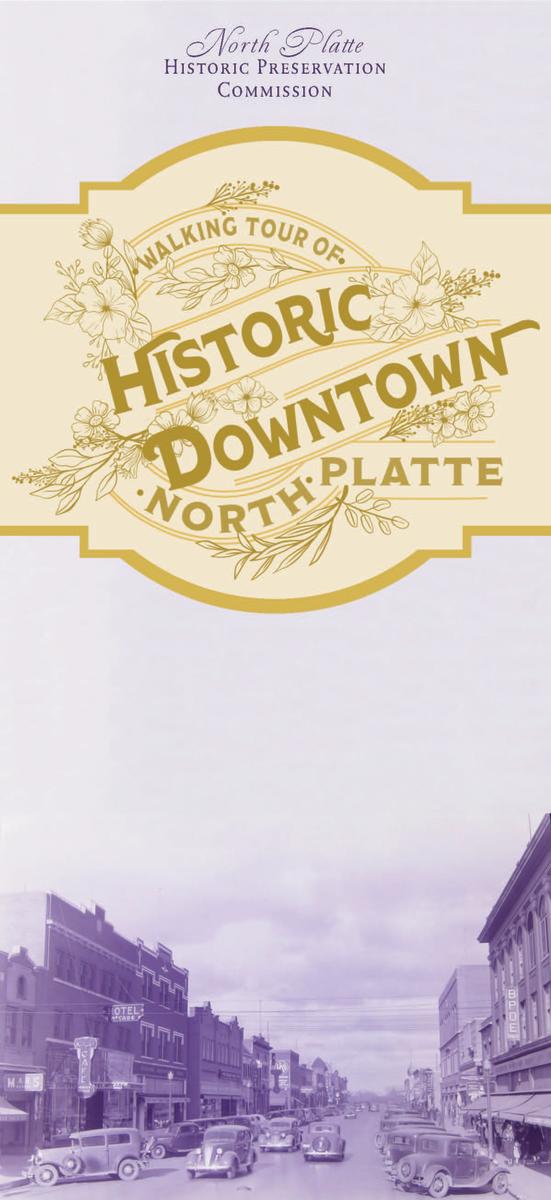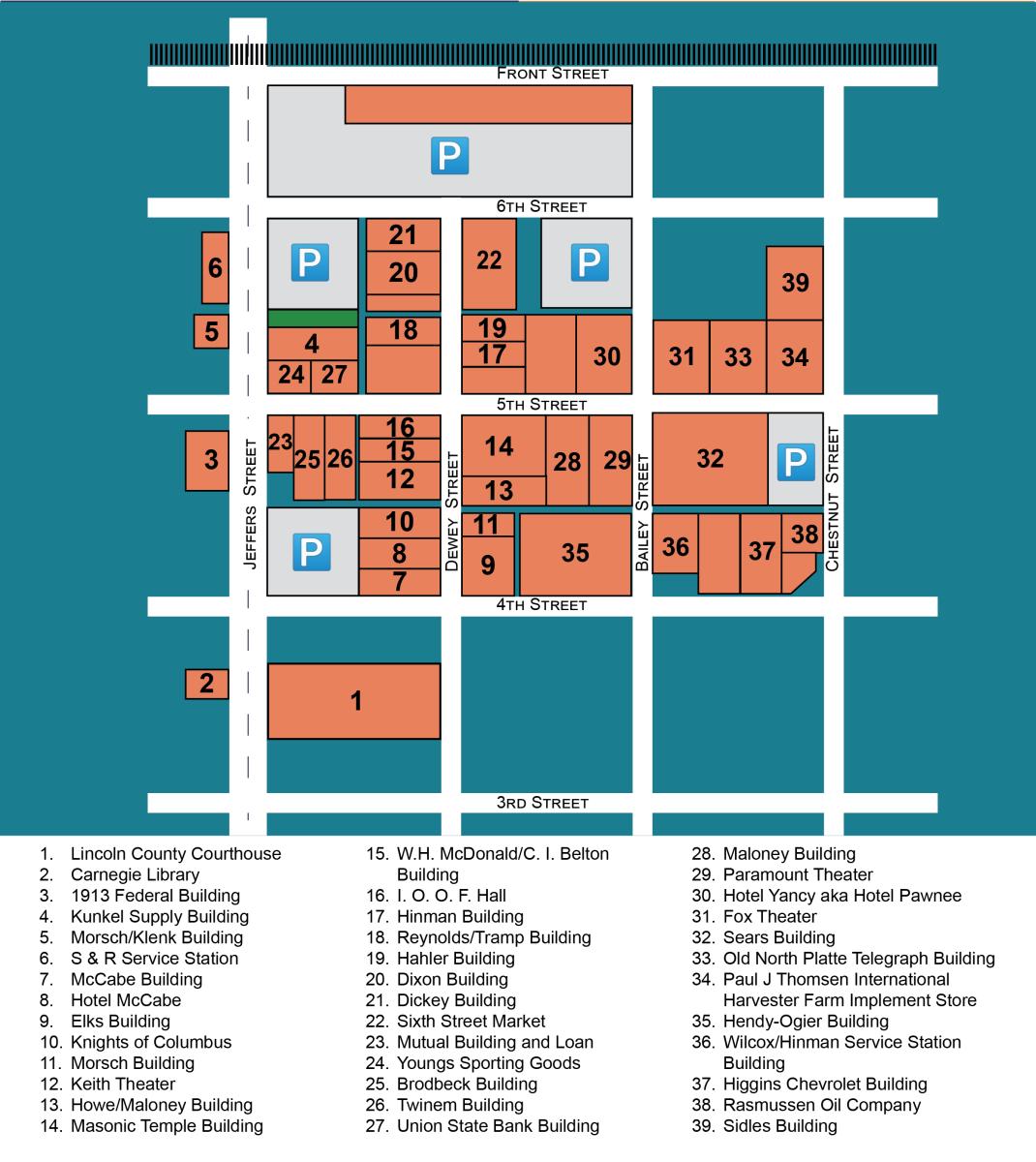Walking Tour of Historic Downtown North Platte
The city of North Platte, the county seat of Lincoln County, was laid out in the autumn of 1866 near the center of the county on a peninsula about three miles from the forks of the North and South Platte Rivers under the direction of General Grenville Dodge of the Union Pacific Railroad.
Building on the railroad ceased during the winter of 1866-1867 and North Platte became home to “Hell on Wheels” as every kind of vice moved in almost overnight with the construction crews and those that followed them; the gamblers, saloon keepers, and their hangers on. It was said to have had a population of over 3,000 living primarily in tents and shacks, with only a few real buildings. The town had its quota of murders, lynchings, and drunken “broils” that went on around the clock. This era was short-lived and, as the railhead moved west the next summer, the majority of the town moved on to the next end-of-the-tracks town.
The town’s population plummeted to 300 residents, but by the fall of 1867, the railroad had established North Platte as a division point and constructed a roundhouse and other supportive structures. With good jobs available, the town put down roots and began to take on a permanent appearance. The first school opened in the summer of 1868. Law and order came in the fall when Peniston was awarded a contract to build the county jail. By 1869, there was a courthouse, a bank, four churches, numerous stores and shops, a land office, and three newspapers. During its first decade, North Platte was also the end of the Texas cattle trail. It was said that during the summer and fall there were so many longhorns trampling through town to the railroad stockyards that it was unsafe to be afoot on the streets.
As a division point on the railroad, as well as being located in the rich Platte River valley, the town grew steadily. It incorporated as a village in 1873, became a second class city in 1875, and a first class city in 1910 when its population reached 4,793. by 1920, the population had more than doubled to 10,466, reached 17,180 by 1960, and was officially recorded at 23,878 in 2000.
With the arrival of the 1920’s, North Platte soon found itself the home of more than just farmers, ranchers, and railroaders. Bolstered by Prohibition, an illegal underground network of gambling, prostitution, and bootlegging took root in this little city. Run largely by a man named Al Hastings, it is said that when Chicago got too hot for hit men, they came to North Platte while things cooled down. Thus, the name ”Little Chicago” became synonymous with North Platte. The extent of the illegal trades is seen in the number of brothels located on the upper floors of building in the downtown district, 17 to be exact, and the story Anne Cook epitomized in the Nellie Snyder Yost’s book Evil Obsession. Only after a new group of city leaders took control th the election of 1951 were these illegal activities shut down.
The railroad, always a large influence on North Platte, soon gained native-born William Jeffers. After “quitting” school (he hit his teacher) he became a call boy for the Union Pacific. (Before telephones, the dispatcher sent a boy to tell the crewmen when to report to take their trains out.) During the next 47 years, Jeffers rose from the company’s lowest paid jobs to its top position, President of the Union Pacific Railroad.
Once president, Jeffers chose his home town of North Platte to build a “retarder” rail yard. This huge complex on the western edge of town now has a receiving capacity of 1,400 cars. Completed in 1948, it required 51 additional miles of trackage and cost $3.5 million.
Constantly updated and expanded, North Platte’s “Bailey Yard” is now the largest such facility in the world; covering 2,850 acres, reaching a total length of eight miles and containing more than 315 miles of track. As many as 15,000 cars can be sorted per day with an average of 150 trains passing through the yard for destination east, west, and south.
Now overlooking the yard is the Golden Spike Tower & Visitor Center which is an eight-story observation tower that visitors can ascend and take in the massive operation. As if to solidify the relationship between the town and the railroad, the United States Congress named North Platte “Rail Town USA” through the efforts of the Original Town Association.
North Platte also has the distinction of having the first lighted airfield in the country. In 1921, a representative of the United States Post Office asked the town to open an airfield for the use of pilots carrying transcontinental air mail. The Post Office had no money for leasing land or building hangers, but promised that if the city would oblige them, it would be reimbursed as soon as Congress appropriated funds.
Accordingly, North Platte subscribed $45,000 in capital stock and obtained land east of the city. Wooden hangers were built and the field (only a hay meadow) was leveled by hauling in dirt to fill the old buffalo wallows on its surface. The landing strip was then outlined by 100 kerosene lanterns hung on stakes driven into the ground. These lanterns had be cleaned and filled daily and lit each night.
In February 1921, Jack Knight made his famous airmail night flight landing successfully on the “lighted airstrip in the middle of Nebraska.” Although the field remained a hay meadow for the next 20 years, some improvements were made and it continued to serve the county as a major link in aviation. In 1941, a concrete runway and electric lights were added. A terminal building was erected in 1952. Today, its longest runway measures 8,000 feet. (Incidentally, Congress never appropriated the money to pay the original stockholders.)
During World War II, North Platte became famous as the home of the “North Platte Canteen.” With its headquarters in the large, unused dining room of the Union Pacific depot, thousands of volunteers from 125 towns, some as far away as 200 miles, served countless sandwiches, cakes, coffee, candy bars, and magazines to 6 million members of the armed forces. The Canteen was open day and night for 51 months, frequently serving as many as 23 trains and up to 8,000 service men in 24 hours. The story is preserved at the Lincoln County Historical Museum in its “North Platte Canteen” Exhibit, documented in the book, Once Upon a Town, by Bob Greene, and immortalized in the Nebraska Education Television documentary, The Canteen Spirit.
Of course, no history would be complete without mentioning William F. “Buffalo Bill” Cody. Beginning as a bison hunter for the Kansas Pacific Railroad and then scouting for the Untied States Army, he finally gained fame with his “Wild West Show”, which traveled all over the United States and Europe entertaining audiences with tales of the West. Possibly more important was Cody’s responsibility for creating the first organized rodeo in the world. Held on July 4, 1882, it was called the “Old Glory Blowout” and was held in North Platte’s Cody Park. Cash prizes were awarded to the winners of the bucking bronco, buffalo riding, steer roping, and horse racing events. Its legacy can still be found In Nebraska’s official celebration, NEBRASKALand Days, PRCA Buffalo Bill Rodeo.
Today, North Platte is a modern city with thriving businesses and community organizations. However, the visitor can still get a glimpse of its former wild side by visiting and taking in its attractions and historic places.


